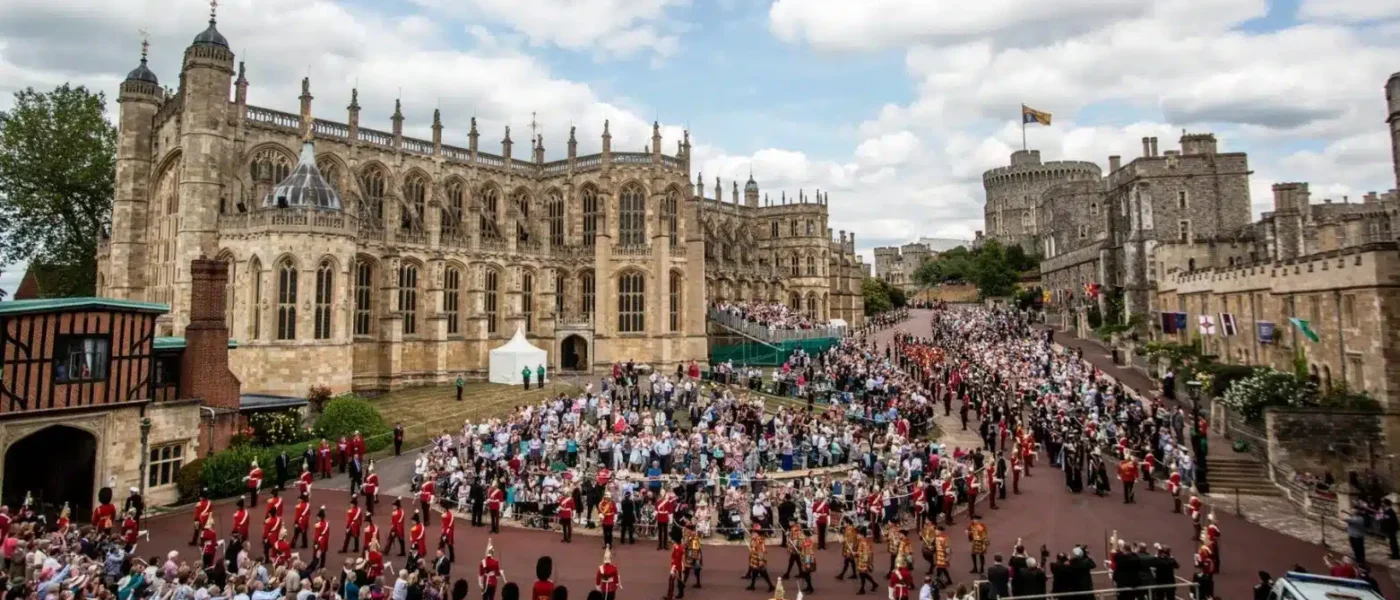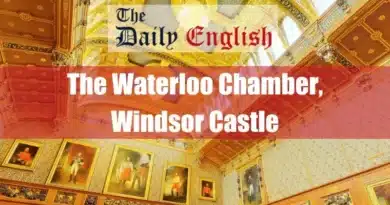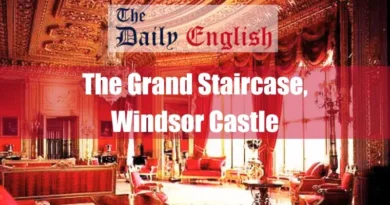I. Introduction
St. George’s Chapel, situated within the majestic grounds of Windsor Castle, stands as a remarkable testament to architectural brilliance, royal heritage, and spiritual significance. This magnificent edifice, a masterpiece of Perpendicular Gothic style, has played a pivotal role in English history, serving as the spiritual home of the Order of the Garter, the most senior order of chivalry in the United Kingdom.
II. Historical Significance of St. George’s Chapel

The origins of St. George’s Chapel can be traced back to the 14th century when King Edward III established it as a collegiate church. However, during the reign of King Edward IV in the late 15th century, the chapel underwent a major expansion and transformation, resulting in the exquisite structure that stands today.
Here is a timeline of the historical events associated with St. George’s Chapel, including dates:
- 1348 – King Edward III establishes St. George’s Chapel as a collegiate church within the grounds of Windsor Castle.
- 1475 – King Edward IV initiates a major expansion and transformation of St. George’s Chapel, guided by the expertise of architect Henry Janyns and overseen by his esteemed counsellor, Sir Reginald Bray.
- 1483 – The choir and its aisles of the expanded St. George’s Chapel are completed and roofed.
- 1496 – The nave of the newly expanded St. George’s Chapel is completed.
- 1528 – The stone vaulting of the expanded St. George’s Chapel is finished, marking the completion of the chapel’s major reconstruction.
- 1547 – King Henry VIII is buried at St. George’s Chapel, following his reign from 1509 to 1547.
- 1547 – King Henry VIII’s third wife, Jane Seymour, was interred at St. George’s Chapel.
- 16th and 17th centuries – St. George’s Chapel becomes the primary venue for the installation ceremonies of the Knights and Ladies of the Garter, the most senior order of chivalry in the United Kingdom.
- 18th and 19th centuries – St. George’s Chapel continues to serve as a significant location for royal weddings and coronations, including the coronation of King George IV in 1821.
- 20th century – St. George’s Chapel becomes the final resting place for several notable monarchs, including King George V and Queen Mary, who were buried in 1936 and 1953, respectively.
- 2021 – St. George’s Chapel hosts the funeral service of Prince Philip, Duke of Edinburgh, following his passing in 2021.
- 2022: Queen Elizabeth II is interred at St. George’s Chapel, following her state funeral at Westminster Abbey.
- Present Day: In addition to these notable events, St. George’s Chapel continues to hold regular worship services and other ceremonies throughout the year.
Throughout its history, St. George’s Chapel has played a pivotal role in British history, serving as a spiritual sanctuary, a stage for royal ceremonies, and a final resting place for monarchs and distinguished individuals. Its enduring architectural beauty and profound connection to the British monarchy continue to inspire and captivate visitors from around the globe.
Today, St. George’s Chapel remains an active place of worship, welcoming visitors from around the globe to admire its architectural splendour and delve into its rich history.
- Also, read Windsor Castle Opening Times: Everything You Need to Know.
- Also, read Windsor Castle Tickets: A Proven Comprehensive Guide.
III. Architectural Style and Features

St. George’s Chapel is a masterpiece of Perpendicular Gothic architecture, a style that flourished in England during the late 15th century. This distinctive style is characterized by its emphasis on verticality, intricate fan vaulting, and elaborate stained glass windows.
A. Soaring Verticality
The chapel’s soaring verticality is immediately apparent upon entering. The walls rise to meet the ceiling in a seamless sweep, creating an impression of lofty grandeur. The slender piers further accentuated this sense of height and pointed arches that support the vaulting.
B. Intricate Fan Vaulting
One of the most striking features of St. George’s Chapel is its magnificent fan vaulting. This intricate web of stone ribs and tracery spread across the ceiling, resembling an inverted fan. The fan vaulting’s intricate design adds to the chapel’s visual beauty and is crucial in distributing weight and supporting the roof.
C. Elaborate Stained Glass Windows
The chapel’s interior is bathed in a kaleidoscope of colours as sunlight streams through its elaborate stained-glass windows. These windows, dating back to the 15th and 16th centuries, depict biblical scenes, saints, and heraldic symbols. The vibrant colours and intricate designs create a sense of awe and wonder, enhancing the chapel’s spiritual ambience.
- Also, know about The Best Bits of Windsor Castle
- Windsor Guildhall Near Windsor Castle: Past and Today
D. Notable Architectural Elements
Beyond its overall architectural style, St. George’s Chapel boasts several notable architectural elements that showcase the artistry and craftsmanship of the Perpendicular Gothic period. These include:
1. The Quire:

The quire, the heart of the chapel, is adorned with exquisite wood carvings and stained glass windows. The Knights and Ladies of the Garter stalls, adorned with their coats of arms and helmets, line the quire’s walls.
2. The Painted Chamber:
The Painted Chamber, a lavishly decorated room adjoining the quire, served as the private chapel of Henry VIII. Its walls are adorned with intricate paintings depicting religious scenes and heraldic emblems.
- Also, read Windsor Castle Changing of the Guard: Where History Coming Alive.
- Also, read Windsor Castle Tour: A Comprehensive and Best Guide.
3. The West Window:

The west window, a masterpiece of 15th-century stained glass, depicts the Last Judgment and scenes from the life of St. George.
4. The Albert Memorial Chapel:

The Albert Memorial Chapel, a neo-Gothic addition to the chapel, was built in honour of Queen Victoria’s husband, Prince Albert. The chapel’s interior is adorned with mosaics, sculptures, and stained glass windows.
5. The West Door:

The West Door, the main entrance to the chapel, is a masterpiece of late medieval craftsmanship. It is adorned with intricate carvings depicting biblical scenes and heraldic symbols. The door’s imposing size and intricate details create a sense of grandeur and reverence.
6. The Pulpit:

The pulpit, dating from the 16th century, is an exquisite example of Renaissance woodwork. It is decorated with carved panels depicting biblical scenes and surmounted by a canopy adorned with pinnacles and finials.
7. The Choir Screen:

The choir screen, a decorative barrier separating the quire from the nave, is a fine example of Perpendicular Gothic woodwork. It is adorned with elaborate carvings depicting saints, angels, and heraldic symbols.
8. The Garter Stalls:

The Knights and Ladies of the Garter stalls, located within the quire, are adorned with their coats of arms, helmets, and banners. These heraldic emblems create a visually stunning display and reinforce the chapel’s connection to the Order of the Garter.
9. The Roof Bosses:

The roof bosses decorative ornaments adorning the intersections of the vaulting ribs are intricately carved with figures of saints, angels, and mythical creatures. These bosses add to the chapel’s visual richness and provide a glimpse into the medieval mindset that shaped its design.
10. The Royal Vault:
The Royal Vault beneath St George’s Chapel was built in 1810 in Windsor Castle and is the final resting place of 24 members of the British royal family, including three monarchs: King George III, King George IV, and King William IV. Among the other notable figures entombed are Princess Amelia, the youngest daughter of King George III, and Prince Philip, the husband of Queen Elizabeth II.
St. George’s Chapel’s harmonious blend of Perpendicular Gothic architecture, intricate craftsmanship, and rich historical significance is a testament to this architectural style’s enduring power and beauty.
- Also, read Windsor Castle Tickets Advantage Card: Know Everything.
- Also, read Exploring Buckingham Palace to Windsor Castle Journey.
- Also, read The Windsor Castle Dogs.
IV. Association with the Order of the Garter
St. George’s Chapel stands as a spiritual sanctuary and a grand stage for the Order of the Garter, the most senior order of chivalry in the United Kingdom. Since its establishment in 1348 by King Edward III, the Order of the Garter has profoundly connected to St. George’s Chapel, making it the order’s spiritual home and the setting for its most significant ceremonies.
A. The Most Noble Order of the Garter
The Most Noble Order of the Garter, founded by King Edward III, is the oldest and most prestigious order of chivalry in the United Kingdom. It is limited to 24 Knights Companions and one Sovereign, the order’s head. The order is bestowed upon individuals who have made exceptional contributions to the nation or rendered personal service to the Sovereign.
B. Installation Ceremonies and Stalls
St. George’s Chapel serves as the venue for the Order of the Garter’s installation ceremonies, where new Knights and Ladies are formally admitted into the Order. These ceremonies, steeped in tradition and grandeur, take place in the chapel’s quire, where the stalls of the Knights and Ladies are located.
C. Heraldry and Banners of the Knights and Ladies of the Garter
The quire of St. George’s Chapel is adorned with the heraldic symbols and banners of the Knights and Ladies of the Garter, creating a visually stunning display of the Order’s rich history and tradition. These heraldic emblems serve as a reminder of the Knights’ and Ladies’ noble lineage and their commitment to the Order’s ideals of chivalry and honour.
D. Annual Service and Garter Day
Each year, on St. George’s Day, a grand service is held at St. George’s Chapel to celebrate the Order of the Garter. This service, known as the Annual Service or Garter Day, is attended by the Sovereign, the Knights and Ladies of the Garter, and other dignitaries. The service is marked by pomp and ceremony, reflecting the Order’s long-standing traditions and enduring significance.
E. Spiritual Significance for the Order
Beyond its ceremonial role, St. George’s Chapel holds deep spiritual significance for the Order of the Garter. The chapel serves as a place of worship and reflection for the Knights and Ladies, who gather there to pray and seek guidance. The chapel’s sacred atmosphere and rich symbolism reinforce the Order’s commitment to Christian values and its dedication to upholding the ideals of chivalry.
St. George’s Chapel, with its intimate connection to the Order of the Garter, stands as a testament to the enduring power of chivalry and the enduring significance of traditions. The chapel’s grand architecture, rich symbolism, and spiritual atmosphere provide a fitting backdrop for the Order’s ceremonies and a place of inspiration for its Knights and Ladies.
From its inception, St. George’s Chapel was envisioned by King Edward III as a spiritual sanctuary for the Order of the Garter, a space where Knights and Ladies could gather to reflect, celebrate, and commemorate their membership. Throughout its history, the chapel has played a pivotal role in the Order’s activities, hosting ceremonies, services, and special events that reaffirm the Order’s enduring values.
The chapel’s grand architecture, intricate carvings, and rich symbolism serve as a powerful emblem of chivalry, embodying the Order’s ideals of honour, courage, and justice. Dedicated to preserving its architectural integrity and historical significance, the custodians of St. George’s Chapel ensure that its beauty and grandeur continue to inspire and captivate visitors for generations to come.
- Also, read How Far is Windsor Castle from Buckingham Palace? Royal Mile?
- Also, read Devastating Timeline of the Windsor Castle Fire 1992.
V. Royal Burials and Monuments

St. George’s Chapel has been the final resting place for numerous English monarchs, including Henry VIII, Jane Seymour, and King George VI. Their tombs and memorial chapels are poignant reminders of the chapel’s profound connection to British royalty.
A. Notable Monarchs Buried at St. George’s Chapel
Several notable monarchs have been interred at St. George’s Chapel, including:
- Edward IV (1442-1483): King of England from 1461 to 1470 and 1471 to 1483. Buried in St. George’s Chapel in 1483.
- Henry VI (1421-1471): King of England who reigned from 1422 to 1461 and was briefly restored to the throne in 1470 before his death later that year. He was originally buried at Chertsey Abbey but reburied at St. George’s Chapel in 1484.
- Henry VIII (1491-1547): King of England from 1509 to 1547. Buried in St. George’s Chapel in 1547.
- Jane Seymour (1509-1537): Queen of England from 1536 to 1537, third wife of Henry VIII. Buried in St. George’s Chapel in 1537.
- Charles I (1600-1649): King of England, Scotland, and Ireland from 1625 to 1649. Executed in 1649 and buried in a small vault in the centre of the choir at St. George’s Chapel in 1649.
- George V (1865-1936) and Queen Mary (1867-1953): King George V and Queen Mary were interred in the Royal Vault beneath St. George’s Chapel. King George V, who reigned from 1910 to 1936, was laid to rest there in 1936. Queen Mary followed in 1953. While the exact location within the Royal Vault may not be publicly specified, historical records confirm their internment there.
- George VI (1895-1952): King of the United Kingdom and the British Dominions from 1936 to 1952. Buried in the King George VI Memorial Chapel at St. George’s Chapel in 1969.
- Elizabeth, the Queen Mother (1900-2002): Queen consort of the United Kingdom from 1936 to 1952, widow of George VI. Buried in the King George VI Memorial Chapel at St. George’s Chapel in 2002.
- Queen Elizabeth II (1926-2022): Queen of the United Kingdom and the Commonwealth Realms from 1952 to 2022. Buried in the King George VI Memorial Chapel at St. George’s Chapel in 2022.
- Princess Louise of Saxe-Weimar-Eisenach (1804-1832): First cousin of Queen Adelaide of Saxe-Meiningen, who was the Queen consort of the United Kingdom from 1830 to 1837. Buried in the chapel’s nave in 1832.
- Prince William, Duke of Gloucester (1766-1805): Son of King George III and Queen Charlotte. Buried in the Gloucester Vault beneath the chapel’s choir in 1805.
- Princess Maria, Duchess of Gloucester (1776-1807): Wife of Prince William, Duke of Gloucester. Buried in the Gloucester Vault beneath the chapel’s choir in 1807.
- Prince Albert, Duke of Edinburgh (1819-1861): Consort to Queen Victoria. Buried in the Albert Memorial Chapel, a neo-Gothic addition to St. George’s Chapel, in 1861.
- Also, read The Windsor Castle Fire 1992: A Historical Catastrophe.
- Also, read The Windsor Castle Fire Salvage Operation 1992.
VI. Role in Royal Ceremonies and Celebrations

St. George’s Chapel has long played a central role in royal ceremonies and celebrations, serving as a grand stage for momentous events in British history.
Here is a comprehensive overview of the role of St. George’s Chapel in royal ceremonies and celebrations:
A. A Stage for Royal Weddings
St. George’s Chapel has long served as a grand and symbolic stage for royal weddings, providing a setting imbued with elegance, reverence, and historical significance. The chapel’s rich architectural heritage, intricate details, and spiritual ambience have captivated the world as it witnessed the union of Prince Harry and Meghan Markle in 2018, further cementing its status as a favoured venue for these momentous occasions.
St. George’s Chapel has hosted several royal weddings in addition to the wedding of Prince Harry and Meghan Markle. Here are a few notable examples:
- 1863 – Queen Victoria’s eldest son, Edward VII, married Princess Alexandra of Denmark in the chapel’s quire.
- 1919 – Prince Albert, Duke of York, second son of King George V and Queen Mary, married Lady Elizabeth Bowes-Lyon in the chapel’s nave.
- 1934 – Prince Henry, Duke of Gloucester, third son of King George V and Queen Mary, married Princess Alice of Battenberg in the chapel’s quire.
- 1961 – Princess Marina, Duchess of Kent, niece of Queen Mary, married Prince Michael of Kent in the chapel’s nave.
- 1988 – Princess Anne, the only daughter of Queen Elizabeth II and Prince Philip, married Timothy Laurence in the chapel’s private chapel.
- 1999 – Prince Edward, Earl of Wessex, youngest son of Queen Elizabeth II and Prince Philip, married Sophie Rhys-Jones in the chapel’s quire.
- 2008 – Peter Phillips, son of Princess Anne and Mark Phillips, married Autumn Kelly in the chapel’s nave.
- 2018 – Prince Harry, the grandson of Queen Elizabeth II and Prince Philip, married Meghan Markle in the chapel’s quire.
- 2018 – Princess Eugenie of York, the granddaughter of Queen Elizabeth II and Prince Philip, married Jack Brooksbank in the chapel’s quire.
- Also, read The Extent of Damage to Windsor Castle Due to the 1992 Fire.
- Also, read Restoration of Windsor Castle after Devastating Fire in 1992.
B. A Sanctuary for National Commemorations
St. George’s Chapel extends beyond its role as a venue for royal weddings, serving as a solemn sanctuary for national commemorations and state funerals. Its dignified atmosphere and profound historical significance provide a fitting setting to honour the passing of beloved monarchs and commemorate significant events in British history. In 2021, the chapel hosted the funeral service of Prince Philip, Duke of Edinburgh, marking a poignant moment in the nation’s history. The chapel’s tranquil ambience and rich symbolism provided a space for reflection and remembrance, allowing the public to pay their respects to a man who had dedicated his life to public service.
Here is a list of other notable commemorations held at St. George’s Chapel:
- 1895 – Funeral service of Prince Henry, Duke of Clarence and Avondale, eldest son of Albert, Prince of Wales, and Victoria, Princess Royal.
- 1910 – Funeral service of King Edward VII.
- 1936 – Funeral service of King George V.
- 1952 – Funeral service of King George VI.
- 1979 – Memorial service for Earl Mountbatten of Burma, a prominent British military leader and statesman.
- 2002 – Memorial service for Queen Elizabeth The Queen Mother.
- 2013 – Memorial service for Baroness Thatcher, former Prime Minister of the United Kingdom.
St. George’s Chapel’s solemn atmosphere and profound connection to British history make it a fitting venue for national commemorations, providing a space for reflection, remembrance, and honouring the nation’s history and people.
C. A Symbol of Royal Continuity
St. George’s Chapel’s enduring presence in royal ceremonies and celebrations highlights its profound connection to the British monarchy. Its rich history, interwoven with the lives of monarchs and royal figures, has cemented its status as a symbol of royal continuity and tradition. Amidst the monarchy’s evolution and adaptation to changing times, St. George’s Chapel remains constant, where the monarchy’s past, present, and future converge. The chapel’s enduring beauty and symbolic significance continue to inspire and captivate visitors worldwide, ensuring its continued role as a cornerstone of British royal tradition.
VII. Public Access and Visitor Information

St. George’s Chapel welcomes visitors throughout the year, offering a glimpse into its architectural splendour, historical significance, and ongoing role in royal life.
A. Opening Hours and Admission Fees
1. Opening Hours:
- Monday to Saturday: 10:00 AM to 4:00 PM (last admission 3:15 PM)
- Sundays: Closed, except for Evensong at 5:15 PM
2. Additional Information:
- Admission fees include entry to the State Apartments and the semi-state rooms (open from autumn to spring each year).
- Tickets can be purchased online in advance or at the ticket office on the day of your visit.
- Group bookings are available for ten or more people.
- There is a café and a shop located within the castle grounds.
B. Guided Tours and Special Events
1. Guided Tours:
St. George’s Chapel offers a variety of guided tours to help you make the most of your visit. Tours are led by knowledgeable and passionate guides who will share the chapel’s fascinating history and architectural highlights.
2. Tours available include:
- Public tours: Offered daily at 10:30 AM, 11:30 AM, 12:30 PM, 2:00 PM, and 3:00 PM.
- Private tours: Available by appointment for groups of 10 to 25 people.
- Group tours: Available for groups of 26 people or more.
- Special tours: Offered on select dates throughout the year, such as tours focusing on the chapel’s history, architecture, or stained glass windows.
C. Special Events
St. George’s Chapel hosts a variety of special events throughout the year, including:
- Chapel Choir Evensong: On Sundays at 5:15 PM, Evensong is a beautiful choral service open to the public.
- Organ Recitals: Held on select Thursdays at 1:00 PM, organ recitals feature world-renowned organists performing various classical music.
- Special Lectures: Held on select dates throughout the year, special lectures explore various topics related to the chapel’s history, architecture, and art.
- Seasonal Events: The chapel hosts special events like Christmas concerts and Easter services.
D. How to Book
Tickets to guided tours and special events can be booked online or by calling the chapel’s Visitor Centre.
E. Additional Information
- Guided tours are typically 1 hour long and are limited to 25 people.
- Special events vary in length and capacity.
- Please check the chapel’s website for the most up-to-date information on guided tours and special events.
F. Accessibility Information
Here is a comprehensive overview of the accessibility information for St. George’s Chapel:
1. Physical Accessibility
St. George’s Chapel is committed to providing an accessible and welcoming environment for all visitors. The chapel has several features to make it easier for people with disabilities to access and enjoy the site, including:
- Level access: The main entrance to the chapel is level access, and there is a ramp leading up to the choir stalls.
- Lifts: There are two lifts in the chapel, one in the north and one in the south.
- Accessible toilets: There are two accessible toilets in the chapel, one near the main entrance and one near the choir stalls.
- Induction loop system: The chapel has an induction loop system for visitors with hearing impairments.
- Large print guides: Large print guides are available for visually impaired visitors.
- Assistance dogs: Assistance dogs are welcome in the chapel.
Additional Information
- Visitors with disabilities can request assistance from the ticket office or information desk staff.
- The chapel offers a free audio guide available in several languages, including English, French, German, Spanish, Italian, Portuguese, Russian, Japanese, Korean, and Mandarin Chinese. The audio guide includes the chapel’s history, architecture, and art.
- The chapel also offers a free tactile tour for visitors with visual impairments. The tactile tour is available by appointment and includes a guided tour of the chapel and the opportunity to touch some of the chapel’s objects.
G. Contact Information
For more information about accessibility at St. George’s Chapel, please get in touch with the Visitor Centre:
Telephone: +44 (0)303 123 7777
VIII. Conclusion
St. George’s Chapel is a magnificent testament to architectural brilliance, royal heritage, and spiritual significance. Its soaring vaults, intricate carvings, and rich history have captivated visitors for centuries. St. George’s Chapel holds a profound place in British identity as the spiritual home of the Order of the Garter and the final resting place of numerous monarchs.
St. George’s Chapel is a cornerstone of British history and culture, embodying a bygone era’s architectural achievements, royal traditions, and religious significance. Its enduring beauty and deep-rooted connection to the English monarchy have cemented its place as a national treasure.
The custodians of St. George’s Chapel are dedicated to preserving its architectural integrity and historical significance. Ongoing restoration efforts ensure the chapel’s grandeur and splendour continue inspiring and captivating visitors for generations.










Comments are closed.